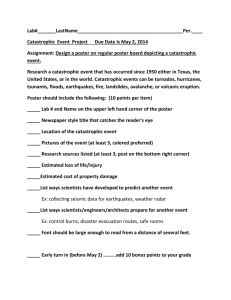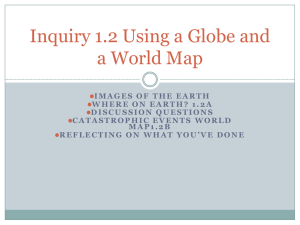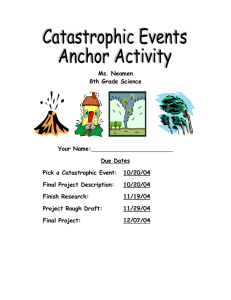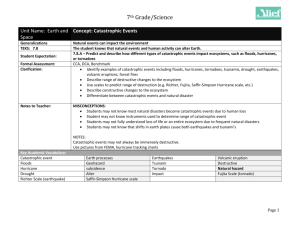Presentation
advertisement
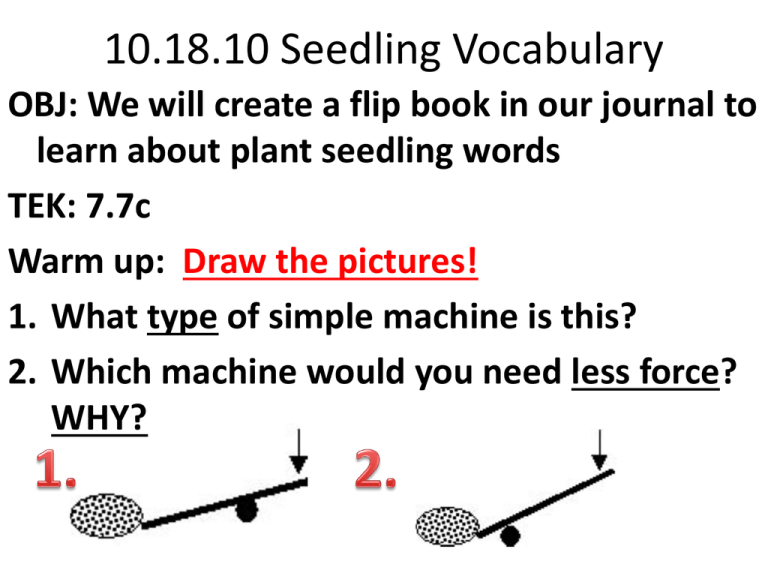
10.18.10 Seedling Vocabulary OBJ: We will create a flip book in our journal to learn about plant seedling words TEK: 7.7c Warm up: Draw the pictures! 1. What type of simple machine is this? 2. Which machine would you need less force? WHY? RECALL: • • • • • • Photo=light Geo= earth Hydro= water Tropo= to turn Ism = a system Thigmo = touch Flip Vocabulary: • Only cut the dotted lines! Past only the little tab labeled Tropism onto your through. Glue tab into your journal Geotropism • Define: How plants respond to the force of gravity. • Draw the pictures: Geotropism: Phototropism Definition: How a plant grows toward the light. Phototropism thigmotropism Definition: Plants bending or growing because of touch TESTS and RETAKES! • The retake test will not be identical so be sure to study before you come to make it up! • Summary: Explain why all the words we learned today have tropism in them. What does this mean? • OUT: Describe how the acorn has both potential and kinetic energy at the same time! • 1st part of test corrections 10.19.10 Seedling • IN: – OBJECTIVE: The students will illustrate seedlings using their journal and flip book. – TEKS: 7.7C – Warm-up: Name at least 3 unbalanced forces that act upon us in our everyday life. Seedling Science Plants come from seeds. Each seed contains a tiny plant waiting for the right conditions to germinate, or start to grow. Seeds wait to germinate until three needs are met: water, correct temperature (warmth), and a good location (such as in soil). Roots Anchor • The seedling's roots push down into the soil to anchor the new plant and to absorb water and minerals from the soil. And its stem with new leaves pushes up toward the light Germination Process • The germination stage ends when a shoot emerges from the soil. But the plant is not done growing. It's just started. New Plant • Plants need water, warmth, nutrients from the soil, and light to continue to grow. • http://www.mbgnet.net/bioplants/grow.html Seedling Poster Rubric • Title • 3 requirements for growth – soil, water, temperature • Draw and Label the stages of seedlings – Root anchors plants, germination occurs, New plant • On back – Name, Date, Period • Recall: Turgor pressure inside the cell allows the root to break free and start to grow. • Summary: Explain how forces inside a seed begin the process for plant growth. • Out: Explain how chemical energy is transformed into thermal energy through digestion when the squirrel eats the acorn. 2nd part Test Corrections 10.20.10 Natural Disasters • IN: – OBJECTIVE: The students will describe different catastrophic events effects on ecosystems using articles – TEKS: 7.8A – Warm-up: Calculate the amount of work done when Bob pushes a 500N box 10 meters. Hurricane Katrina Gulf Oil Spill What is an Ecosystem? • A community of organisms and their abiotic environment • Community – different types of organisms living together in the same place at the same time • Abiotic factors – anything that was never alive and cannot be alive How does it impact the ecosystem? • • • • • • • • Floods Hurricanes Earthquakes Tsunamis Wildfires Tornadoes Volcanoes Drought Natural Disaster Article • In groups of 3 (I choose) Read natural disaster article. • Answer questions • Talk within your group how this disaster could impact the environment and the ecosystem. • Write a group paper on the summary and your conversation. (3-4 SENTENCES to each question) Questions to Answer • What is your Catastrophic event? – My catastrophic event is…… • Where is your catastrophic event primarily located? – My catastrophic event is located…. – This location is important because… – This catastrophic event location means…. • What kind of communities generally live in the area of your catastrophic event? – The type of communities that live in the area are… – The animals that live there are… – The abiotic factors that live there are… • How much harm may your catastrophic event cause? – My catastrophic event will harm… – The catastrophic event causes… • How will your catastrophic event impact the ecosystem? – My catastrophic event will impact the ecosystem… – The catastrophic event will cause…. Essay…. Take answers from questions and place them in paragraph form…. My catastrophic event is……My catastrophic event is located….This location is important because…This catastrophic event location means…. The type of communities that live in the area are…The animals that live there are…The abiotic factors that live there are… My catastrophic event will harm…The catastrophic event causes… My catastrophic event will impact the ecosystem…The catastrophic event will cause…. Present Paper…. Turn in… • Recall: Catastrophic events are natural occurrences that generally have a negative effect on people and/or the environment • Summary: Tell Fred how your catastrophic event could effect you • OUT: Describe how to read the diagram below. 10.21.10 Presentations • IN: – OBJECTIVE: We will present our predictions and descriptions of our catastrophic events. – TEKS: 7.8A – Warm up: Describe catastrophic in your own words. Questions to Answer • What is your Catastrophic event? – My catastrophic event is…… • Where is your catastrophic event primarily located? – My catastrophic event is located…. – This location is important because… – This catastrophic event location means…. • What kind of communities generally live in the area of your catastrophic event? – The type of communities that live in the area are… – The animals that live there are… – The abiotic factors that live there are… • How much harm may your catastrophic event cause? – My catastrophic event will harm… – The catastrophic event causes… • How will your catastrophic event impact the ecosystem? – My catastrophic event will impact the ecosystem… – The catastrophic event will cause…. Essay…. Take answers from questions and place them in paragraph form…. My catastrophic event is……My catastrophic event is located….This location is important because…This catastrophic event location means…. The type of communities that live in the area are…The animals that live there are…The abiotic factors that live there are… My catastrophic event will harm…The catastrophic event causes… My catastrophic event will impact the ecosystem…The catastrophic event will cause…. Present Paper…. Turn in… Natural Disaster Paper • You have 5 minutes to prepare presentation of your catastrophic event. • THE PRESENTATION WILL BE A TEST GRADE!!! Presentations • Present paper to class as a group • 3-5 minutes/group • Takes notes on presentations Paper and Presentation RUBRIC Catastrophic Event Paper and Presentation Paper (50 points) Answered 5 questions (40 points) _____________ Used Complete Sentences (10 points)__________ Wrote in Essay Form(10 points)________________ Presentation (40 points) All people in group spoke (20 points) _________ Described Catastrophic Event (10 points)__________ Predicted impact of Catastrophic event (10 points) ___________ • Recall: Catastrophic events have an effect on ecosystems. • Summary: Predict what would happen in San Antonio if we had a Category 5 hurricane strike the Texas Coast Line in the Gulf of Mexico. • Out: RETAKE TOMORROW! – Describe how force and motion relate to catastrophic events. 10.22.10 Presentations • IN – Objective: We will present our predictions and descriptions of our catastrophic events. – TEKS: 7.8A – Warm up: When a volcano erupts, would an ecosystems’ temperature increase or decrease? Presentations • Present paper to class as a group • 3-5 minutes/group • Takes notes on presentations Retake Test • You will only get the remaining of the period for the retake test • Recall: scientists can predict the outcomes of catastrophic events • Summary: What was your favorite presentation and WHY!? • OUT: Name the catastrophic event and how it could happen.
